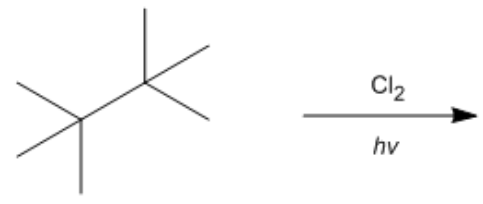In the study of radical halogenation, the stability of the radical cation intermediate plays a crucial role in determining the selectivity of the reaction. Typically, the most stable radical is found at the tertiary position, but the behavior of different halogens can vary significantly. This concept can be illustrated through an analogy of a steakhouse, where the choice of meat represents different halogenation reactions.
Fluorination, akin to a diner who indiscriminately chooses a hot dog, is highly exothermic with an enthalpy change of \(-432 \, \text{kJ/mol}\). This reaction is nonselective and can lead to unpredictable outcomes, making it less useful for practical applications in radical halogenation. The extreme exothermic nature of fluorination can even render it explosive, thus it is generally avoided.
Chlorination, represented by a diner who opts for familiar dishes like meatloaf, has a less negative enthalpy of \(-101 \, \text{kJ/mol}\). While still exothermic and spontaneous, chlorination is not very selective either, especially when multiple types of hydrogens (primary, secondary, tertiary) are present in the organic compound. This results in a mixture of products, as chlorination does not preferentially target the most stable radical.
Bromination, on the other hand, is likened to a discerning diner who seeks the finest cuts of meat, such as Wagyu beef. With an enthalpy value of \(-26 \, \text{kJ/mol}\), bromination is less exothermic than fluorination and chlorination, allowing for greater selectivity. It preferentially reacts with the most stable radical cation intermediate, making it the most reliable method for halogenating alkanes.
Finally, iodination is compared to a diner who refuses to partake in the meat selection altogether. With a positive enthalpy of \(+53 \, \text{kJ/mol}\), iodination is endothermic and nonspontaneous, requiring an input of energy to proceed. This lack of spontaneity means that iodination is not a viable option for radical halogenation.
Additionally, when discussing chiral products resulting from these reactions, it is important to note that bromination can lead to racemic mixtures. This occurs when bromine can approach the chiral center from either side, resulting in two possible products with equal probability, thus creating a racemic mixture.
In summary, understanding the qualitative selectivity of different halogens in radical halogenation reactions is essential. The varying exothermic properties and selectivity of fluorination, chlorination, bromination, and iodination highlight the importance of choosing the right halogen for specific organic transformations.









